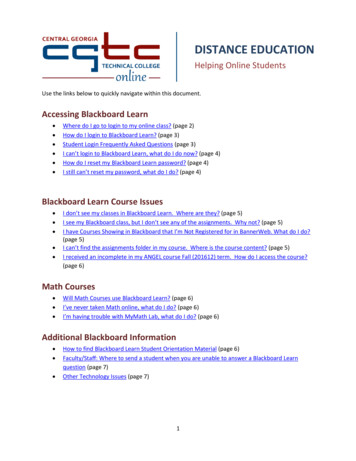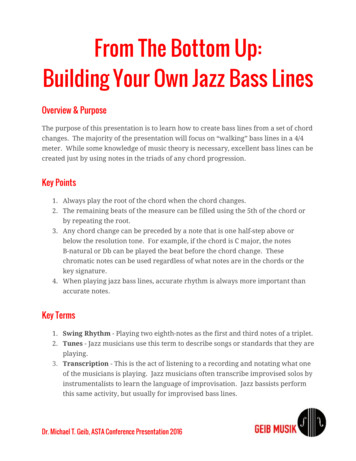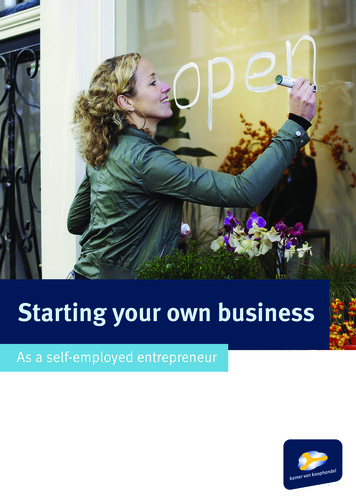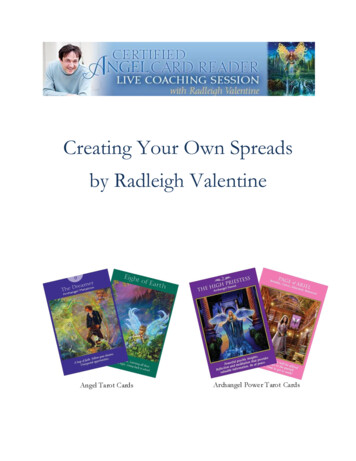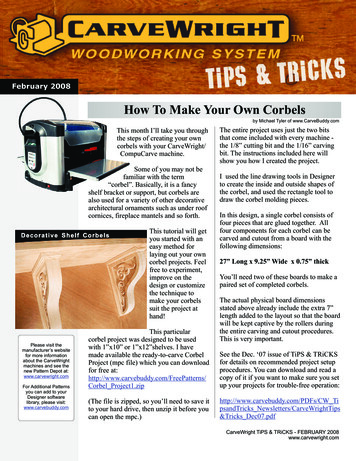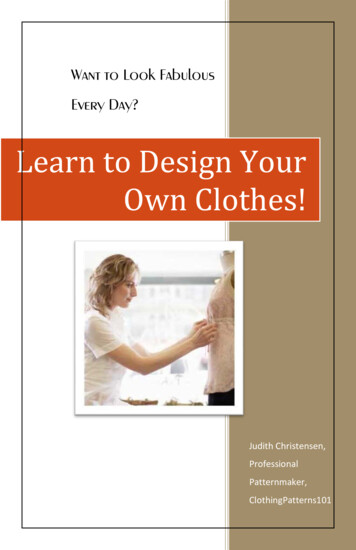
Transcription
Want to Look FabulousEvery Day?Learn to Design YourOwn Clothes!Judith rns101
Table of ContentsYes, You CAN Design Your OwnClothes!.4Planning YourDesign . .8Elements of Design and How They’reUsed . . 10Your Basic Block or FittingPattern .14Variations on the BasicBlock. . . .15Keep Your Balance! MaintainingProportion . .22Design with Fabric andColor .26Where to findinspiration. .31Ethnic Inspiration .352
Historic Inspiration . .37Putting the PiecesTogether 41Croqui . . 43Conclusion 443
Express Your Creativitywith Clothing You DesignYourself!Think you don’t have what it takes to design yourown clothing?Nonsense!Clothing design is little more than taking a varietyof style elements and putting them together increative new ways. Change a sleeve, a collar, theshape of a skirt – and you’ve just designed a newstyle!4
When paging through a magazine or watching TVor a movie, do you notice what people arewearing and think, “That looks fabulous!” Or –“Wow, that’s not a good style for her shape.”One of the first steps to designing your ownclothes is recognizing good design and whatappeals to you when you see it on someone else.Do you often look at a garment and think, “I lovethat neckline”, or “What a beautiful sleeve”, or “Ilove the way that skirt flows”.If you do, then you are a designer! Being able topick out styling details – and identify why you likea particular garment – allows you to getinspiration from those details and use them inyour own designs.5
If you sew yourown clothes fromcommercialpatterns you buy atthe fabric store,you already makedesign decisionsregarding style,color, and fabric.And when you shopfor clothes, don’tyou often think, “Idon’t like .(thecolor, the collar,the sleeves )” ?You’re makingdesign decisionsthen, too!
If you’re ready to step up to the next level andcreate your own fashions, I’ll walk youthrough the process of putting together yourown styles.Fashion is little more than taking simpledesign elements and putting them together inyour own unique way.It’s kind of like a jig-saw puzzle, or playing withpaper dolls. You mix and match sleeves,collars, skirts, and so on until you get apleasing arrangement – voila! You’vedesigned something!
Planning Your DesignThere are certain aspects of design, bothpractical and aesthetic, to take intoconsideration when you plan a garment.For example, if you want to design a dress, youmay ask yourself: Where do you plan to wear this dress? Forwhat kinds of events or activities? Is it“dressy”, business-like, casual?Keeping the purpose of the dress in mind,do you want it long? Short? Somewhere inbetween?Where do you want the waist to sit – at,above, or below your natural waistline?(this will affect the type of skirt and bodiceyou choose)Do you want the bodice close-fitting orloose-fitting?Do you want the skirt slim, A-line, gored,full, pleated?8
Or do you want a dress without a waistline– a sheath or a full, flowing style?Do you want sleeves? If so, are they long,short, ¾ length? Full or fitted? With orwithout a cuff?If you don’t want sleeves, how aboutstraps? Or strapless? Or just a sleevelessbodice?Once you’ve decided the basic form andfunction on your dress, you can choose almostany combination of design elements and comeup with a great-looking garment.9
Elements of DesignThe design details you’d use to distinguishyour style include the shape of the neckand/or collar, the length, shape and fullnessof sleeves (with or without cuffs), the shape,length, and fullness of a skirt, or the length,shape and fullness of a top or blouse.These style details - like bell sleeves, fullsleeves, shawl collars, V-necklines – can beadded to a basic bodice or blouse in anynumber of combinations, each creating a newand different style.The examples on the next page are all basicblouses – but each has different styling details.One has a Peter Pan collar and full sleeves,another has a shawl collar and short sleeves,and another has bell sleeves and a V-neckline.Each as a different look – but all are based onthe same basic body.10
Re-arrange these basic design elements, andyou can create any number of differentblouses! Put the shawl collar on the fullsleeved blouse, or the Peter Pan collar on the11
short sleeve blouse – or any other combinationof details you choose.If you love the neckline you see on a blouse,imagine it on a dress, in a different color andfabric, or on a casual top.Design is all about trying differentcombinations of elements until you find onethat appeals to you.It’s the details that make a great design, butdon’t overdo it.Don’t put too many details into one garment.They will compete with each other and you’lllose the impact of each one individually.Each detail speaks volumes – too manyand you’ll have a shouting match!12
Designing with Darts and SeamsDarts and shaping seamscan also be used as designelements.Princess seams arecommonly used to give thegarment shape and fit. Butthey also add style to aplain sheath.The yoke on a skirt is a shaping seam whichalso functions as a design detail. The yokeallows the skirt to fit closely through the hips,and adds detail to an otherwise simple skirt.13
Your Basic Block or FittingPatternBefore you design yourfirst garment, you’llneed a pattern block –one that fits you like aglove.A pattern block, or basicblock, is a simplegarment, withabsolutely no stylingdetails.It is, frankly, a veryboring fitting dress!!But that boring dress islike a blank slate towhich you will applyyour design magic.You’ll make fit adjustments to this basic dressuntil the fit is perfect – then you can addwhatever details you like, to design fashionsthat fit and flatter you.14
Simple Variations on theBasic BlockStarting with yourbasic block, you’ll add“style lines” anddetails to create yourmasterpiece.Style lines arechanges to thepattern usedprimarily to achievethe look you want,not for fit.You can get some verynice looking dresses,blouses, and tops withDress with 2-piece look just a few style linesadded to the block,This dress is a simpleand details like belts,variation on the basicsleeves, or collars.block. The 2-piece lookwith contrast skirt keepsthe waist seam, adds abelt, and moves thebodice darts to the neck.15
This simple dresskeeps the fittedbodice withflattering princessseams replacing thedarts for fit.The skirt has softpleats that swingnicely – using a verysimple adjustmentcalled “slashing andspreading” to addshape and fullnessto the skirt.High Waist Dress withFull Skirt16
The “Illusion” dress hasshaped panels at thesides to give theappearance of asmaller waist.Like princess seams,the side panels not onlyadd color and shape,the seams function asdarts or shaping seamsto customize the fitwithout the use ofwaist or hip darts.“Illusion” Dress withContrast Side Panels17
There are almostunlimited optionswhen it comes tosleeves, necklines,skirt shape, blouseor top length andoverall fit.Use the bodice ofthe basic block tomake a top orblouse – the yoke,bell sleeves, andslight flare at thehem are all stylelines that create thiseasy-fitting style.The yoke effectively“hides” the bustdarts, too, givingthe top a nice fitover the bustwithout noticeabledarts.Tunic with shaped yoke18
Or, turn it into anunstructured jacketwith curved overlap –it’s really just a minorvariation on the bodiceblock!Design is, to a greatextent, just a matter of“mixing and matching”those elements untilyou have a style thatyou like.Unstructured Jacketwith Curved Openingand Bell Sleeves19
For example, addbracelet-lengthsleeves to the 2piece look dress andthe dress looks a bitmore elegant.Or keep the casualsleeveless look, butmake the skirt fulland swing-y – a verydifferent look!Just switch the details around, and you have anew style.20
All of these styles – and many, many more can be made using the simple dress blockdescribed at the beginning of this chapter.Learn how to do a variety of sleeves,necklines, yokes, and other design elements –and you can design anything!21
Maintaining Balance andProportionAs you’re choosing the individual parts thatmake up you dress, keep in mind proportion –both yours and that of the dress itself. Someshapes will look better on you than others andI’m sure that by now you have a pretty goodidea what works on you and what doesn’t.In general, the partsof your garmentshould give a sense ofbalance. A long tunicstyle top over abelow-the-knee skirtseldom looksbalanced.22
Long over short or short over long looks better!In a similar way, full and fitted balance eachother.A full top over a fullskirt is too much; itadds pounds23
The same full top over a slim skirt is muchbetter, more balanced. Or, a more fitted topwith the full skirt works well.Finally, keep your own proportions and bodyshape in mind.Many larger women (like myself) gravitate tooversized clothing to hide their size. But inreality, excess fullness just makes us lookbigger!24
Tight-fitting clothing, on the other hand, oftenlooks like we’ve outgrown the item (andsometimes, that’s exactly what’s happened!) –and it’s also not flattering.But a natural fit, relatively close but notbinding, with well balanced design, looksgreat on everyone.25
Design with Fabric andColorThe final selections for your design are fabricand color. These are often the most importantconsiderations, and a change of fabric, print,and/or color can make the same dress look likean entirely new style.The softness, stiffness, drape, or “hand” ofthe fabric is a very important considerationwhen choosing a fabric for your dress orgarment.A circle skirt, for example, can be soft andflowy, or it can stand out like a poodle skirt.Dior’s New Look of the 1950’s used full, circleskirts (worn with a crinoline) for a shape thatemphasized the waist by flaring the skirt.26
A circle skirt in a softfabric drapes nicelyThe same circle skirt, ina firmer fabric holds itsflared shape.For a full skirt that hangs and movesbeautifully, use a fluid fabric like crepe orchallis. For a flared skirt, use a firmer fabriclike taffeta or poplin.In another example, a very soft, flowing fabricwill not work for crisp-looking pleats. Thepleats won’t hang properly and won’t have anice, neat edge. For crisp pleats, use a firmerfabric like wool or linen.27
Some styles can be made in both soft andfirmer fabrics; you’ll just get a different lookwith each.A gored skirt, forexample, is not too fulland tends to fit fairlyclosely through the hips.In a soft, loose weaveor knit fabric, the skirtwill swing and floweasily.In a firmer fabric,like a light-weightdenim, it will havemore structure andshape.Notice how theaddition of apointed yoke andcontrasttopstitching28
gives this skirt a very Western feel – justchanging a few simple elements gives you anentirely different look.Get to know your fabrics and how they reactto the construction of the garment you wantto make.Feel the fabric you’re considering and lift itfrom the bolt. Does it hold it’s shape or drapeloosely? Both are good features; you just needto be aware of when and how to use them.29
Changing the color or print of the fabric canalso make a garment look entirely new.A basic dress with waist wrap may besophisticated and dressy in a nice black crepe,or light and casual in a bold graphic print.It’s the combination of silhouette, fabricand color (or print) that determines the“look” and feel of a garment.30
Where to Find Inspiration forYour DesignsWhere do you go to get ideas for your designs?Almost anywhere! If you want to stay currentwith the latest trends, you can find inspirationfrom other designers.By “inspiration”, I do NOT mean that youshould copy other designers. You’ll want tocreate your own look and reflect your ownpersonality, not that of someone else.Look for specific details that you canincorporate – the neckline, the hemline, thefabrics or embellishments used - and use it ina new and different way.For example, a peplum is a nice detail thatdefines the waist – you can add it to thebottom of a blouse or the top of a skirt.31
The peplum top is a freshtake on a simple blouse –it’s a great shape foralmost every body type.The uneven hemlineand turtle-shell printof the simplesleeveless top updatea straight black skirt.Uneven or asymmetrical hems make a top,blouse, or dress more interesting and can beused on almost any style.32
Follow fashion magazines on Facebook orPinterest, and read print issues.If you love celebrity fashion, watch the redcarpet entrances of award shows. While youmight not need an evening gown, some of thedetails can be translated into a cocktail dressor more casual wear. Look for trends, like theheight and shape of hemlines, symmetry, theshape of sleeves (or the lack of sleeves), andthe shape of necklines and skirts.Many catalogs and retailers also have currentfashions, designed for everyday wear. Followyour favorites and you’ll find lots of details youcan put together into your own interestingstyle.33
Color-blocked MondrianDress with a ‘60’s FeelNavy Sheath with aVan Gogh inspiredprintYou’ll also get inspiration from the art world(the art-inspired, color-blocked Mondriansheath, above, is an example), from historicfashions, or from ethnic costume.Pinterest is a fabulous resource for vintagefashions and ethnic designs as well as currenttrends.34
Explore the World and FindInspiration in Ethnic FashionsThe classic Chinese Cheongsam (or “SusieWong”) dress was very popular in the early‘60’s in the US.The detail I love aboutit is the curvedopening on thewearer’s right side. Inthe dress (which is avery fitted sheath),this opening hides azipper that continuesalong the side seam,to the waist.35
I’ve used it in aside-buttonedtopand a sleevelesssummer dress –the gentle cu
Fashion is little more than taking simple design elements and putting them together in your own unique way. It’s kind of like a jig-saw puzzle, or playing with paper dolls. You mix and match sleeves, collars, skirts, and so on until you get a pleasing arrangement – voila! You’ve designed something! 8 Planning Your Design . There are certain aspects of design, both practical and aesthetic .File Size: 1MBPage Count: 44

